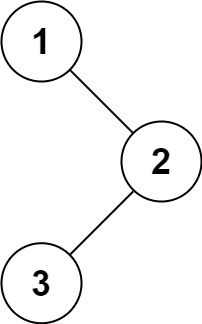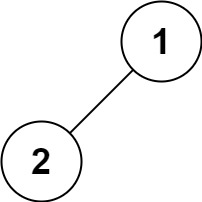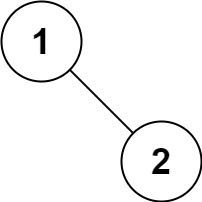LeetCode - Easy - 144. Binary Tree Preorder Traversal
Topic
- Stack
- Tree
Description
https://leetcode.com/problems/binary-tree-preorder-traversal/
Given the root of a binary tree, return the preorder traversal of its nodes’ values.
Example 1:

Input: root = [1,null,2,3]Output: [1,2,3]
Example 2:
Input: root = []Output: []
Example 3:
Input: root = [1]Output: [1]
Example 4:

Input: root = [1,2]Output: [1,2]
Example 5:

Input: root = [1,null,2]Output: [1,2]
Constraints:
- The number of nodes in the tree is in the range
[0, 100]. -100 <= Node.val <= 100
Follow up: Recursive solution is trivial, could you do it iteratively?
Analysis
方法一:递归法。
方法二:迭代法。
Submission
import java.util.ArrayList;import java.util.LinkedList;import java.util.List;import com.lun.util.BinaryTree.TreeNode;public class BinaryTreePreorderTraversal {public List<Integer> preorderTraversal(TreeNode root) {List<Integer> result = new ArrayList<>();preorderTraversal(root, result);return result;}private void preorderTraversal(TreeNode root, List<Integer> result){if(root == null) return;result.add(root.val);preorderTraversal(root.left, result);preorderTraversal(root.right, result);}public List<Integer> preorderTraversal2(TreeNode root) {List<Integer> result = new ArrayList<>();LinkedList<TreeNode> stack = new LinkedList<>();if(root != null) stack.push(root);while(!stack.isEmpty()) {TreeNode node = stack.pop();result.add(node.val);if(node.right != null)stack.push(node.right);if(node.left != null)stack.push(node.left);}return result;}}
Test
import static org.junit.Assert.*;import org.hamcrest.collection.IsEmptyCollection;import org.hamcrest.collection.IsIterableContainingInOrder;import org.junit.Test;import com.lun.util.BinaryTree;public class BinaryTreePreorderTraversalTest {@Testpublic void test() {BinaryTreePreorderTraversal obj = new BinaryTreePreorderTraversal();assertThat(obj.preorderTraversal(BinaryTree.integers2BinaryTree(1, null, 2, 3)), //IsIterableContainingInOrder.contains(1, 2, 3));assertThat(obj.preorderTraversal(null), IsEmptyCollection.empty());assertThat(obj.preorderTraversal(BinaryTree.integers2BinaryTree(1)), //IsIterableContainingInOrder.contains(1));assertThat(obj.preorderTraversal(BinaryTree.integers2BinaryTree(1,2)), //IsIterableContainingInOrder.contains(1,2));assertThat(obj.preorderTraversal(BinaryTree.integers2BinaryTree(1,null,2)), //IsIterableContainingInOrder.contains(1,2));}@Testpublic void test2() {BinaryTreePreorderTraversal obj = new BinaryTreePreorderTraversal();assertThat(obj.preorderTraversal2(BinaryTree.integers2BinaryTree(1, null, 2, 3)), //IsIterableContainingInOrder.contains(1, 2, 3));assertThat(obj.preorderTraversal2(null), IsEmptyCollection.empty());assertThat(obj.preorderTraversal2(BinaryTree.integers2BinaryTree(1)), //IsIterableContainingInOrder.contains(1));assertThat(obj.preorderTraversal2(BinaryTree.integers2BinaryTree(1,2)), //IsIterableContainingInOrder.contains(1,2));assertThat(obj.preorderTraversal2(BinaryTree.integers2BinaryTree(1,null,2)), //IsIterableContainingInOrder.contains(1,2));}}



































还没有评论,来说两句吧...